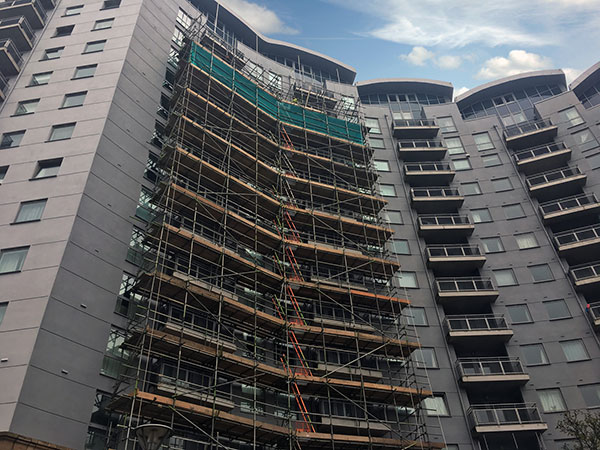Going the Extra Mile: Improving Efficiency with Industrial Scaffolding

Within the constantly changing landscape of building, business scaffolding stands as a vital component that enhances efficiency and safety in various projects. From skyscraping high-rises to complex renovations, scaffolding provides the necessary backing and access to work at heights, guaranteeing that teams can execute their duties effectively. However, what precisely is commercial scaffolding, and why has it become essential in the contemporary construction sector? Grasping its importance not only assists satisfy compliance requirements but also facilitates smoother project management, eventually resulting in favorable outcomes.
As we delve into the realm of business scaffolding, we will investigate various kinds of scaffolding structures, their function in enhancing job site security, and the regulatory guidelines such as OSHA guidelines that govern their application. Additionally, we will underscore key considerations for selecting the appropriate scaffolding solutions for your particular project needs, including high-rise constructions to commercial and office developments. Ultimately, at the conclusion of this conversation, you will have a comprehensive understanding of how proper scaffolding strategies can revolutionize construction processes, guaranteeing both security and productivity at every step.
Grasping Business Frameworks
Commercial frameworks is a temporary framework utilized to assist employees and resources during the building or refurbishment of business facilities. It offers a secure and stable platform for building activities at different heights, facilitating workforces to perform duties efficiently. Scaffolding is essential in large projects where conventional ladders or framework alternatives may not suffice, allowing for greater access to multiple levels of a facility, enhancing workflow, and confirming that work can be completed in a timely way.

There are several categories of scaffolding used in commercial projects, including frame scaffolding, system frameworks, and tubular frameworks. All kind serves different functions and is picked based on factors such as the project's distinct requirements, elevation, and difficulty. For example, system frameworks is extremely flexible and can be modified for various site layouts, while structured frameworks is commonly used for simple duties that do not require significant customization. Comprehending the distinct categories helps site managers determine the most effective approach for their needs.
The role of scaffolding in current erection cannot be overemphasized. It not only boosts work security by delivering safe surfaces for laborers but also adds to productivity by reducing the time laborers invest traveling between different floors. As business projects often involve teams working together on various tasks simultaneously, suitable framework solutions enable continuous processes, reduce hindrances, and foster an organized site atmosphere. Ultimately, proper scaffolding is vital for successful project finishing, adhering to schedules, and maintaining high protection standards.
Security and Adherence in Scaffold Systems
Ensuring safety and compliance is crucial in scaffold operations, especially in commercial projects where the stakes are significant. Employers must adhere to strict safety regulations set forth by organizations such as the Occupational Safety and Health Administration, which provide guidelines that help ensure a secure working environment for all workers involved. https://blogfreely.net/islandsquare3/the-impressive-scaffold-alliance-collaborating-on-business-initiatives with these regulations not only protects workers but also reduces legal that can occur from incidents or dangerous practices on the worksite.
Education is a vital aspect of safety compliance in scaffold systems. Workers must be equipped with the necessary expertise and skills to identify potential hazards and apply safety protocols effectively. This entails grasping how to conduct security inspections, correct use of equipment, and adhering to safety protocols. By supporting comprehensive training initiatives, companies can foster a culture of safety, ensuring that staff are alert and prepared to address any issues that may arise while working at heights.
Furthermore, regular maintenance and checks of scaffold systems are crucial for ongoing security adherence. This involves checking for soundness, wear and tear, and verifying all components are operating properly. By performing meticulous inspections and upkeeping equipment, construction companies can proactively identify and resolve issues, thereby guaranteeing the security of their workers and the complete success of the project. A dedication to safety and adherence not only enhances worker protection but also boosts the productivity and standing of the company as a whole.
Scaffolding Systems for Modern Projects
In today's rapid construction industry, efficient scaffolding solutions are crucial for the effective completion of modern projects. With the increasing complexity and size of business builds, scaffolding systems must be versatile and responsive. Modularized scaffolding has become as a preferred choice in this context, offering rapid assembly and disassembly, which reduces downtime on site. This flexibility allows contractors to respond quickly to project changes and maintain tight schedules, thereby enhancing productivity and efficiency.
Worker safety remains a top priority in any construction project, and advanced scaffolding systems incorporate features specifically developed to mitigate risks. Modern scaffolding equipment often includes protective rails, non-slip surfaces, and automatic locking mechanisms to improve worker safety. Moreover, these systems are designed to comply with the most current OSHA standards and industry guidelines, ensuring that job sites maintain a satisfactory level of safety for all workers. Training programs tailored to educate workers with the specific scaffolding systems being used further enhance the commitment to a safe working culture.
The role of scaffolding in the execution of large-scale jobs, such as high-rise buildings or expansive commercial complexes, cannot be ignored. Effective project planning and logistics play a vital role in the scaffolding installation, including factors such as load capacity and site accessibility. Selecting the appropriate type of scaffolding and understanding the unique requirements of each job ensures that construction efforts proceed efficiently. As jobs continue to evolve, embracing innovative scaffolding solutions will be key to enhancing overall efficiency, maintaining safety guidelines, and achieving job success in contemporary construction.
